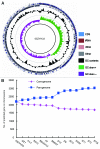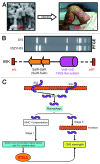Streptococcus suis infection: an emerging/reemerging challenge of bacterial infectious diseases?
- PMID: 24667807
- PMCID: PMC4063810
- DOI: 10.4161/viru.28595
Streptococcus suis infection: an emerging/reemerging challenge of bacterial infectious diseases?
Abstract
Streptococcus suis (S. suis) is a family of pathogenic gram-positive bacterial strains that represents a primary health problem in the swine industry worldwide. S. suis is also an emerging zoonotic pathogen that causes severe human infections clinically featuring with varied diseases/syndromes (such as meningitis, septicemia, and arthritis). Over the past few decades, continued efforts have made significant progress toward better understanding this zoonotic infectious entity, contributing in part to the elucidation of the molecular mechanism underlying its high pathogenicity. This review is aimed at presenting an updated overview of this pathogen from the perspective of molecular epidemiology, clinical diagnosis and typing, virulence mechanism, and protective antigens contributing to its zoonosis.
Keywords: Streptococcus suis; pathogenesis; zoonosis.
Figures




References
-
- Feng Y, Shi X, Zhang H, Zhang S, Ma Y, Zheng B, Han H, Lan Q, Tang J, Cheng J, et al. Recurrence of human Streptococcus suis infections in 2007: three cases of meningitis and implications that heterogeneous S. suis 2 circulates in China. Zoonoses Public Health. 2009;56:506–14. doi: 10.1111/j.1863-2378.2008.01225.x. - DOI - PubMed
Publication types
MeSH terms
LinkOut - more resources
Full Text Sources
Other Literature Sources
Medical
Miscellaneous
